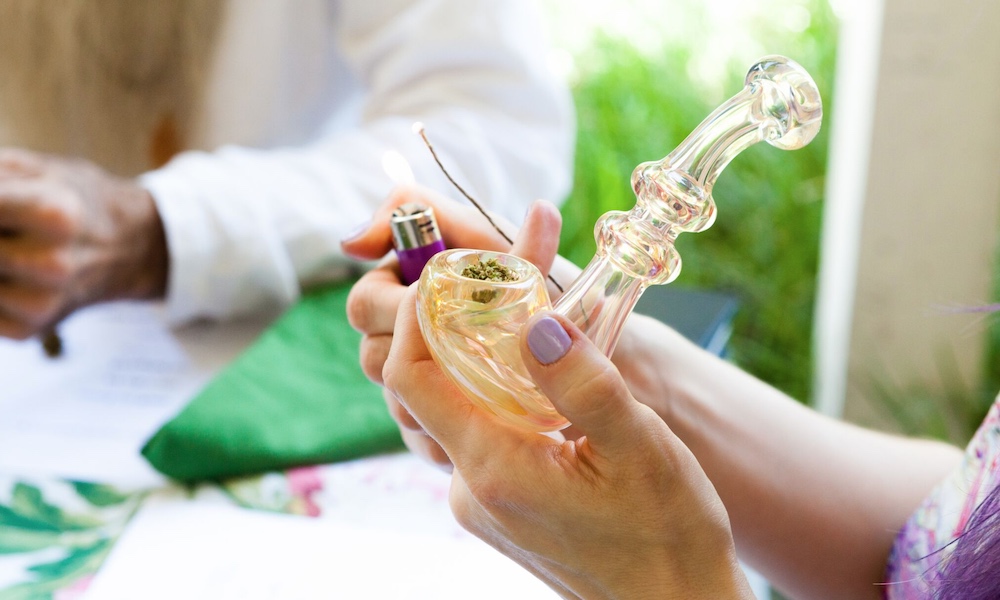The average cannabis user living in states where marijuana is legal has the luxury of stepping inside his or her friendly neighborhood dispensary for access to a variety of pot products, like edible candies, pills, topicals, concentrates and even beverages. These processed variations of the cannabis plant are designed for those consumers who don’t necessarily want to smoke to achieve the desired effect. But when it comes to which method of consumption is best for patients suffering from chronic pain, a new study suggests that loading a bowl full of flower is still the most effective path to getting back to good.
Researchers at the University of New Mexico determined that people trying to manage pain through the use of cannabis are simply better off smoking bud than relying on other forms of the herb. The findings, which were published in the journal Complementary Therapies in Medicine, indicate that “whole cannabis flower was associated with greater pain relief than were other types of products.” The researchers go on to say that “higher tetrahydrocannabinol (THC) levels were the strongest predictors of analgesia and side effects prevalence across the five pain categories.”
These results are especially interesting considering that cannabidiol (CBD), the non-intoxicating compound of the cannabis plant, is now being praised as a rockstar at taming pain. Even the folks pushing the hemp-derived version of this medicine, which is much weaker than the oils made from marijuana, swear that this sometimes truck stop novelty is the key to living pain-free. However, researchers beg to differ. They have concluded that the presence of THC, which produces the stoned effects we all know and love, is also essential if the user expects any discernible pain-relief results.
“Cannabis flower with moderate to high levels of (THC) is an effective mid-level analgesic,” the study reads.
But it just isn’t the existence of THC that makes smoking marijuana the best approach to pain management.
We have swelled into a society convinced that dissecting cannabis and separating its components into good and evil is the right approach to the plant. This is perhaps the reason that CBD has risen to such stardom in the past five years. The problem with this attitude is that it completely disregards the 100 or so other cannabinoids that the cannabis plant has to offer. It also discounts essential terpenes and flavonoids and thereby eliminates any possibility that the patient will benefit from the plant’s synergistic properties. Science established long ago that the entourage effect associated with whole-plant cannabis is what truly provides the therapeutic effects. So, all of you military service members prohibited from using CBD products, don’t worry, you’re definitely not missing much.
But what about kids suffering from epilepsy? Dr. Sanjay Gupta told us years ago that they needed the CBD compound to stop seizures. Sure, while some sick children might have had some luck controlling this affliction through the use of CBD alone, a study published around this time last year found the compound was more effective at helping them stay seizure-free if it was complemented with just a hint of THC. Researchers found that the closer they got to allowing the two cannabinoids to work together, the better the results. “We saw a statistically significant reduction in motor seizures, and an increase in seizure-free days,” the study authors said.
Although the U.S. Food and Drug Administration (FDA) approved a CBD-based drug last year called Epidiolex to be prescribed to young patients suffering from two rare forms of epilepsy, not even it is expected to be a miracle cure. The drug, which contains absolutely no THC, is only effective in around 32% of patients, according to the FDA. Parents with epileptic kids have long complained that CBD alone just doesn’t do the trick and that the efficacy of this compound has been hyped beyond belief.
The latest study out of New Mexico, however, provides some guidance for an America looking for answers as to whether marijuana can relieve pain or not.
A separate study published earlier this week from the American Society of Anesthesiologists (ASA) shows that 75% of the U.S. population, most of them millennials, has a genuine interest in learning more about how pot can combat pain conditions. These folks, presumably those fed up with all of the anecdotal reports and the conflicting studies that emerge every other week, want to see the federal government finally roll up their sleeves on the cannabis issue and deliver real results.
Unfortunately, it seems that medical marijuana users are going to have to get high before they experience any noticeable pain relief. And that complicates things for a vast majority of the U.S. population — especially those in the workforce. Unlike over-the-counter pain remedies like acetaminophen and ibuprofen, which eliminate some of the hurt without a buzz, smoking marijuana to combat minor aches could lead to impairment issues on the job. Just like most companies don’t allow workers to drink booze on the clock, medical marijuana is not likely to be any different, even after federal legalization finally takes hold in the new few years. So, don’t sell your stock in Tylenol just yet.

